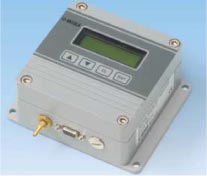|
| Front page | | Contents | | Previous | | Next |
Alternatives to mercury-containing measuring devices
4 Barometers
4.1 Application of mercury-containing barometers
Barometers measure atmospheric pressure.
Barometers are used for a number of professional applications, among these in weather stations (e.g. the stations of the Danish Meteorological Institute or the Danish Forest and Nature Agency), airports and airfields, offshore installations (e.g. windmill parks) and on ships.
Mercury barometers contain elemental mercury in a thin glass column. The mercury rises and falls with changes in atmospheric pressure.
In Denmark, sale of mercury barometers is only allowed for calibration of other barometers. The Danish Meteorological Institute has today only one mercury barometer, "the institute reference", which is rarely used for certain calibration purposes today (Nehring 2006). Usually accurate electronic barometers based on the "vibrating cylinder transducer" principle are used for calibration purposes. Contacted suppliers of barometers for professional applications today solely use electronic barometers for calibration of other barometers (Dahl 2006; Røien 2006).
Previous mercury consumption in Denmark
The mercury consumption with barometers in Denmark has been considered marginal, and the undertaken substance flow analyses do not specifically quantify the consumption of mercury with barometers in Denmark. The total consumption of mercury with barometers in the UK around 2000 was estimated by Floyd et al. (2002) at 35 kg in 875 items. Assuming a similar per capita consumption in Denmark the consumption would have been around 3 kg.
Information sources from manometers of other countries report that barometers contain 40-1000 g Hg (Floyd et al. 2002) or 395-622 g (NEWMOA, 2006).
Applications for which mercury may be reintroduced
Apart from certain calibration purposes, no critical applications have been identified. The electronic devices are apparently superior to mercury-containing devices for all professional applications. According to a supplier small local airfields may still use their old mercury-containing equipment, as the automatic reading of the meter is not essential (Røien 2006). Small airfields seem to be one application area, where mercury-containing barometers might be reintroduced, if they could be supplied at a significantly lower price than electronic devices.
4.2 Alternatives for main application areas
A number of alternative barometers are marketed, among these:
- Electronic barometers based on vibrating cylinder air pressure transducers;
- Electronic resistance or capacitance barometers;
- Aneroid mechanical barometers.
For professional use, electronic barometers for automatic data logging seem to represent the whole market today, whereas aneroid barometers may still be used for application in household.
Electronic barometer with vibrating cylinder air pressure transducers
A vibrating cylinder air pressure transducer is designed to measure absolute air pressure using the vibrating element principle, providing a frequency output from which pressure is computed. The pressure is applied to a thin-walled metal cylinder, which is set into motion at its natural frequency by electromagnetic drivers. As the air pressure inside the cylinder changes, the resonant frequency of the cylinder also changes.
Accurate barometers, e.g. for calibration of other barometers at the Danish Meteorological Institute, are based on the vibrating cylinder air pressure transducers principle (Nehring 2006).
Electronic resistance or capacitance barometers
A widely applied type of electronic barometers contain a sensor with electrical properties (resistance or capacitance) that changes, as the atmospheric pressure changes. These sensors are considered to be just as accurate as a traditional mercury barometer or an aneroid barometer (Gallican et al. 2003). Additional electronic circuitry converts the sensor output into a digital display or an automatic data logger. These barometers are today in Denmark applied in weather stations, ships, airports, etc. (Dahl 2006).
 |
EXAMPLE:
Vaisala PTB220 Series Digital Barometer. Marketed as "barometric pressure standard, electronic alternative for a Hg barometer, weather stations, data buoys and ships, laser interferometers". Uses a silicon capacitive absolute pressure sensor. (Vaisala Oyj, Finland)
Supplier: ED Service-Center, Roskilde, Denmark |
| Source: http://www.edsc.dk/ |
Aneroid mechanical barometer
The mechanical aneroid barometer (aneroid = liquid-free) is more compact than the mercury barometer and consists of an evacuated metal diaphragm linked mechanically to an indicating needle. As atmospheric pressure increases or decreases, the diaphragm compresses or expands, causing the indicating needle to show the change in pressure. Aneroid barometers have been used for approximately 200 years and are considered just as accurate as the traditional mercury barometer. (Gallican et al. 2003). No suppliers of aneroid barometers for professional use have been identified, and that barometer is probably not marketed for this application area in Denmark.
4.3 Summary
Electronic barometers for automatic data reading have totally replaced mercury barometers for professional use in Denmark. The electronic barometers are as precise as the mercury barometers and have the advantage of automatic data logging. The electronic barometers may be more expensive than mercury thermometers, but the lower price of mercury barometers would most probably not be a decisive property for the main part of the professional users.
Gallican et al. (2003) concludes that the aneroid and electronic barometers are cost effective in use and acceptable alternatives to the mercury barometer.
Table 4.1 Marketed alternatives for mercury-containing thermometers in Denmark
| Application area / product type |
Marketed alternatives |
Price of alternatives compared to mercury technology |
Comment |
| Weather stations, ships, offshore installations, etc. |
Electronic resistance or capacitance barometers |
Not assessed |
Danish suppliers do not have an indication of the price of relevant mercury barometers |
| High-accuracy barometers, e.g. for calibration |
Electronic barometer with vibrating cylinder air pressure transducers |
Not assessed |
Danish suppliers do not have an indication of the price of relevant mercury barometers |
| Front page | | Contents | | Previous | | Next | | Top |
Version 1.0 March 2006, © Danish Environmental Protection Agency
|
